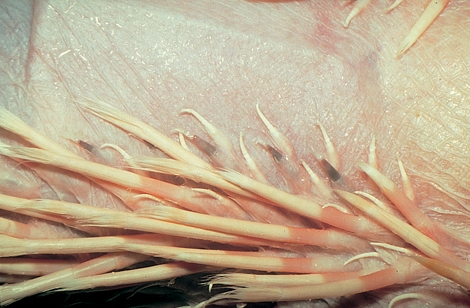Difference between revisions of "Avian Medicine Q&A 03"
Jump to navigation
Jump to search
| (One intermediate revision by the same user not shown) | |||
| Line 13: | Line 13: | ||
|q1= What is the morphological diagnosis? | |q1= What is the morphological diagnosis? | ||
|a1= Multifocal follicular and feather pulp haemorrhage. | |a1= Multifocal follicular and feather pulp haemorrhage. | ||
| − | |l1= | + | |l1= |
|q2= What is the aetiological agent? | |q2= What is the aetiological agent? | ||
|a2= These haemorrhages, which can vary in severity, are typical of polyomavirus infection in young psittacines. | |a2= These haemorrhages, which can vary in severity, are typical of polyomavirus infection in young psittacines. | ||
| − | |l2= | + | |l2= |
|q3= What internal lesions would you expect? | |q3= What internal lesions would you expect? | ||
|a3= Depending on the species of psittacine, there is hepatic enlargement and variable necrosis, and splenomegaly. Generalized serosal haemorrhages may be present and, in a few cases, intestinal necrosis and haemorrhage are noted. | |a3= Depending on the species of psittacine, there is hepatic enlargement and variable necrosis, and splenomegaly. Generalized serosal haemorrhages may be present and, in a few cases, intestinal necrosis and haemorrhage are noted. | ||
| − | |l3= | + | |l3= |
|q4= How can a definitive diagnosis be made? | |q4= How can a definitive diagnosis be made? | ||
|a4= | |a4= | ||
| Line 25: | Line 25: | ||
*Swabbing affected organs and submitting the swab for DNA probe testing is definitive, and, in cases with poorly developed lesions, may be the only way of making a positive diagnosis. | *Swabbing affected organs and submitting the swab for DNA probe testing is definitive, and, in cases with poorly developed lesions, may be the only way of making a positive diagnosis. | ||
*Cloacal swabs may be assessed by PCR for the presence of polyomavirus. | *Cloacal swabs may be assessed by PCR for the presence of polyomavirus. | ||
| − | |l4= | + | |l4= |
</FlashCard> | </FlashCard> | ||
| Line 32: | Line 32: | ||
desc none}} | desc none}} | ||
[[Category: Avian Medicine Q&A]] | [[Category: Avian Medicine Q&A]] | ||
| + | [[Category:To Do - Manson]] | ||
Revision as of 21:29, 2 August 2011
| This question was provided by Manson Publishing as part of the OVAL Project. See more Avian Medicine questions |
The photo above shows gross appearance of feathers from a young cockatoo that died following a short clinical illness.
| Question | Answer | Article | |
| What is the morphological diagnosis? | Multifocal follicular and feather pulp haemorrhage.
|
[[|Link to Article]] | |
| What is the aetiological agent? | These haemorrhages, which can vary in severity, are typical of polyomavirus infection in young psittacines.
|
[[|Link to Article]] | |
| What internal lesions would you expect? | Depending on the species of psittacine, there is hepatic enlargement and variable necrosis, and splenomegaly. Generalized serosal haemorrhages may be present and, in a few cases, intestinal necrosis and haemorrhage are noted.
|
[[|Link to Article]] | |
| How can a definitive diagnosis be made? |
|
[[|Link to Article]] | |
